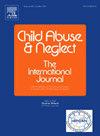网络儿童性侵害的普遍性和特征:来自澳大利亚儿童虐待研究的发现。
IF 3.4
2区 心理学
Q1 FAMILY STUDIES
引用次数: 0
摘要
背景:网络儿童性侵害越来越多地受到技术的促进,但其普遍性和特征的证据仍然很少。可靠的基于人群的数据对于了解问题的严重性和性质以及为基于证据的预防提供信息至关重要。目的:确定任何犯罪者未经同意分享儿童性图像的流行程度,以及任何成年犯罪者在线性引诱的流行程度;并确定这些经历的特征。参与者和环境:澳大利亚有3500名16-24岁的全国代表性样本,包括澳大利亚儿童虐待研究(ACMS)参与者的子样本。方法:采用青少年受害调查问卷- r2:改编版(ACMS)。调查项目收集了参与者的自我报告信息,包括在18岁之前,他们是否经历过任何犯罪者未经同意分享自己的性照片,以及成年人在网上的性引诱。后续项目生成了关于这些体验特征的信息。我们为每一种经历生成加权的全国患病率估计值,并估计了慢性(经历发生的次数)、发病年龄和犯罪者特征。结果:未经同意分享18岁前儿童性图像的全国患病率为7.6% (95% CI 6.6- 8.6%),成人在线性引诱的患病率为17.7% (95% CI 16.3- 19.2%)。在18岁之前,女孩比男孩更有可能经历未经同意的图片分享受害者(10.9% vs 3.8%)和成人在线性引诱(26.3% vs 7.6%)。性别不同的个体经历了更高的网络性引诱(47.9%),尽管细胞大小较小。网络性引诱的慢性性(中位数:n = 5)高于非自愿的图片分享受害者(中位数:n = 2)。发病的中位数年龄为15岁(图片分享)和14岁(性引诱)。大多数未经同意分享图片的肇事者是其他已知的青少年(48.8%)和现在或以前的恋人(23.4%),而在线性引诱的肇事者通常是未知的成年人(86.7%)。结论:网络儿童性侵害在澳大利亚很普遍,尤其是女孩。许多孩子的经历始于童年中期,而且往往是慢性的。结果可以为加强有针对性的预防工作提供信息。本文章由计算机程序翻译,如有差异,请以英文原文为准。
Prevalence and characteristics of online child sexual victimization: Findings from the Australian Child Maltreatment Study
Background
Online child sexual victimization is increasingly facilitated by technology, but evidence of its prevalence and characteristics remains scarce. Reliable population-based data is critical to understand the magnitude and nature of the problem, and inform evidence-based prevention.
Objective
To determine the prevalence of nonconsensual sharing of sexual images of the child by any perpetrator, and of online sexual solicitation by any adult perpetrator; and to determine the characteristics of these experiences.
Participants and setting
A nationally representative sample of 3500 individuals aged 16–24 years in Australia, comprising a sub-sample of participants in the Australian Child Maltreatment Study (ACMS).
Methods
We administered the Juvenile Victimization Questionnaire-R2: Adapted Version (ACMS). Survey items captured self-reported information from participants about whether, before age 18, they had experienced nonconsensual sharing of sexual images of themselves by any perpetrator, and online sexual solicitation by an adult. Follow-up items generated information about the characteristics of these experiences. We generated weighted national prevalence estimates for each experience, and estimated chronicity (number of times the experience occurred), age at onset, and perpetrator characteristics.
Results
National prevalence of nonconsensual sharing of sexual images of the child before age 18 was 7.6 % (95 % CI 6.6–8.6 %), and of online sexual solicitation by an adult was 17.7 % (95 % CI 16.3–19.2 %). Girls were significantly more likely than boys to experience both nonconsensual image sharing victimization (10.9 % v 3.8 %) and online sexual solicitation by an adult (26.3 % v 7.6 %) before age 18. Gender diverse individuals experienced higher online sexual solicitation (47.9 %), although cell sizes were small. Chronicity of online sexual solicitation (median: n = 5) was higher than nonconsensual image sharing victimization (median: n = 2). Median ages at onset were 15 (image sharing) and 14 (sexual solicitation). Most perpetrators of nonconsensual image sharing were other known adolescents (48.8 %) and adolescents who were current or former romantic partners (23.4 %), while perpetrators of online sexual solicitation were typically unknown adults (86.7 %).
Conclusions
Online childhood sexual victimization is widespread in Australia, especially for girls. Many children's experiences begin in middle childhood, and events are often chronic. Results can inform enhanced targeted prevention efforts.
求助全文
通过发布文献求助,成功后即可免费获取论文全文。
去求助
来源期刊

Child Abuse & Neglect
Multiple-
CiteScore
7.40
自引率
10.40%
发文量
397
期刊介绍:
Official Publication of the International Society for Prevention of Child Abuse and Neglect. Child Abuse & Neglect The International Journal, provides an international, multidisciplinary forum on all aspects of child abuse and neglect, with special emphasis on prevention and treatment; the scope extends further to all those aspects of life which either favor or hinder child development. While contributions will primarily be from the fields of psychology, psychiatry, social work, medicine, nursing, law enforcement, legislature, education, and anthropology, the Journal encourages the concerned lay individual and child-oriented advocate organizations to contribute.
 求助内容:
求助内容: 应助结果提醒方式:
应助结果提醒方式:


